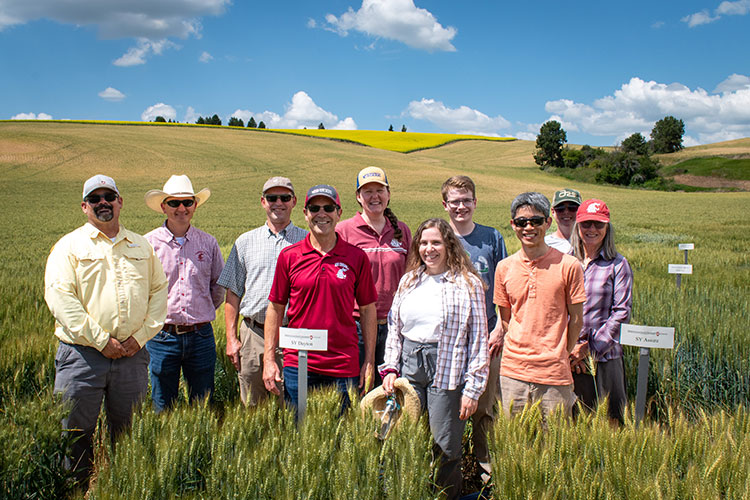Examining current research for low falling numbers
The conclusion of our three-part series discusses ongoing research that addresses common concerns with falling numbers and conveys current management and mitigation strategies that can be employed by those in the “grain chain.” Distrust in the falling number method comes from two collective concerns by the industry: lack of consistent results between testing facilities and inconsistency between samples from the same lot. In our January Wheat Life article, we reported that not all testing facilities are Federal Grain Inspection Service (FGIS) certified, which may cause nonrepeatable results, and how to determine if results are valid. Notably, some variation (within 25 seconds) between valid tests of the same lot is
still considered acceptable.
Current research
Two avenues of research aim to understand where further variation is coming from and if it can be controlled or corrected for. The first is to understand how seed properties, like protein or starch, are contributing to lower falling numbers, specifically in the absence of detectable alpha-amylase activity. This effort has been ongoing for several years with collaborators from Oregon State University, University of Idaho (UI), the Wheat Marketing Center, Washington State University (WSU), and the U.S. Department of Agriculture (USDA). This research is expected to reduce falling number variation with variety improvement. The second is to understand how sampling from growers’ trucks, the development of composite samples, and testing locations might be contributing to variation. Preliminary results suggest that if FGIS sampling, composite, and testing guidelines are followed, then they are not significant sources of variation; however, more work is needed to validate these findings. The only significant source of variation found in this study was caused by field topography, not human error at elevators or testing facilities.

Limited understanding of the developmental timing and weather patterns that cause low falling numbers continue to frustrate the industry. This is particularly true for late maturity alpha-amylase (LMA), first identified in the Pacific Northwest (PNW) in 2012. Unfortunately, we have not yet clearly identified the weather events during grain filling that induce LMA for most PNW varieties. Current research includes greenhouse and growth chamber trials, as well as environmental studies to understand the temperature and moisture parameters that result in LMA. Extension efforts to spread awareness on the causes of LMA include WSU field days, WSU Wheat Academy, Spokane Ag Expo, Tri-State Grain Growers Convention, articles here in Wheat Life, FAQs with the Washington Association of Wheat Growers, WSU Wheat Beat podcasts, WSU Extension articles, and scientific journals (see table for links). However, confusion regarding LMA is still prevalent. Extension efforts will continue with new publications and presentations at local grower meetings.
Innovation in testing methods
Efforts to develop alternatives to the falling number test, both destructive and nondestructive, span decades. One prominent example is the rapid visco-analyzer (RVA) developed in the 1980s (Ross et al., 1987). While the RVA did not replace the falling number test, it has become a fixture for many end-use quality applications. In the 1990s, the WheatRite immunoassay was developed as a cheaper and more accurate alternative (Verity et al.,1999). Unfortunately, due to production challenges and lack of market acceptance, the WheatRite test was eventually discontinued. Despite initial setbacks, improvements in immunoassay test sensitivity and production continue and has propelled efforts to deliver a similar product for detecting low falling numbers. Read about the development of the rapid test in our Wheat Life article at https://bit.ly/3Fl84pa.
Thanks to the support from our WSU, USDA, and stakeholder networks, the rapid test took another step forward in 2023. Efforts included growing, sourcing, and testing samples for falling numbers spanning 200 to 400 seconds, which were shipped to our industry partner EnviroLogix. More than 300 samples representing 50 geographic regions in the PNW and 75 breeding lines or varieties were tested. EnviroLogix is using these samples to calibrate the rapid test with falling numbers according to different wheat market classes. We have retained many of these samples for in-house beta-testing, which we hope to begin this spring, with site-specific beta-testing this harvest.
Ongoing needs
In 2017, the industry identified the need for prediction tools to help identify when low falling numbers might occur in a geographical region. A collaboration between WSU, UI, and the USDA to develop predictive models and an early-warning system based on weather events is ongoing. These models will be refined and tested to maximize performance through grower participation using the rapid test when it becomes available. Although elevator capacity limitations hinder the ability to segregate and store grain for long periods of time, an early-warning system may provide a way to identify where to focus early testing efforts and better manage problems. An early-warning system also enhances evaluation of newly developed varieties. Ongoing breeding efforts to develop varieties with robust climate resiliency is critical, as well as the need to empower seed handlers and growers with information about, and access to, the best varieties for specific regions. The oftentimes isolated nature of LMA and preharvest sprouting events makes variety selection for specific geographic regions essential to avoid problems.
Current management and mitigation
- Growing the best variety for your location. This is the only premanagement tool available.
- Avoid green kernels at harvest, which have high alpha-amy-lase activity. Just a few green kernels can lower the falling number for an entire lot.
- Follow best sampling and composite development practices.
- Ensure your falling number is from a valid test!
- Report to researchers when you think you have a problem: alison.thompson@usda.gov or ahauvermale@wsu.edu.
To improve variety performance and prediction tools, we are asking for grower and elevator participation:
- What varieties are being grown and where, especially if you identified a potential problem. i.e. What weather events occurred?
- What cardinal direction of what county, i.e. northwest Whitman County, and, if comfortable, the town you are closest to.
- Other management information such as soil amendments, spraying, tilling, etc.
By providing this information, you can help tackle the low falling numbers problem for the PNW. Thank you to all the interviewees that participated in our fact-finding mission and
our industry research partners HighLine Grain Growers, Palouse Grain Growers, and The McGregor Company!
More falling number resources
References
Ross AS, Walker CE, Booth RI, Orth RA, Wrigley CW (1987) The Rapid Visco-Analyser: a new technqiue for the estimation of sprout damage. Cereal Foods World 32:827-829
Verity, J. C. K., Hac, L., & Skerritt, J.H. (1999). Development of a field enzyme-linked immunosorbent assay (ELISA) for detection of a-amylase in preharvest-sprouted wheat. Cereal chemistry, 76(5), 673-681.
This article originally appeared in the March 2024 issue of Wheat Life Magazine.

Alison L. Thompson, Ph.D.
Alison L. Thompson, Ph.D., is a plant geneticist and research biologist for the U.S. Department of Agriculture’s Agricultural Research Service (USDA-ARS) Wheat Health, Genetics and Quality Research Unit, based in Pullman. Thompson works on the low falling numbers problem in wheat, as well as characterize adaptation responses of wheat and barley to changing environmental conditions.

Amber Hauvermale, Ph.D
Amber L. Hauvermale, Ph.D., is a research assistant professor in the Department of Crop and Soil Sciences, which is part of the College of Agricultural, Human, and Natural Resource Sciences at Washington State University.
